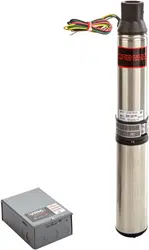Loading ...
Loading ...
Loading ...

Total thickness of the tape should be no less than the
thickness of the conductor insulation.
The following test is recommended before installation.
Cable and splice test for leaks to ground.
1) Immerse the cable and splice connections into a
steel barrel of water with both ends out of the water,
and not touching the barrel. (Figure 3)
2) Set ohmmeter on RX 100K and adjust needle to
zero (0) with leads clipped together.
3) Clip one ohmmeter lead to the barrel and the other
to each cable lead individually.
4) If the needle deflects to zero (0) on any of the cable
leads, a faulty splice connection is indicated. To
double check the faulty splice connection, pull the
splice out of the water. If the needle now moves to
(infinite resistance) the leak is in the splice.
5) Repairs should be made with CSA and/or UL
approved electrical rubber and PVC tape.
6) If the leak is not in the splice, pull the cable out of
the water slowly until the needle moves to ∞. When
the needle moves to ∞, the leak is at that point.
INSTALLING YOUR PUMP
PUMP LOCATION
Your submersible pump should be installed no less
than 5 feet (1.5 meters) from the bottom of your well.
CAUTION: To avoid accidental loss of the pump in the
well, it is recommended that a ¼" polypropylene rope
be permanently attached to the eye provided on the
discharge head of the pump.
The other end of the polypropylene rope should be
secured to an anchor at the well head.
DRILLED WELL INSTALLATION
1) Check your submersible pump and accessories for
physical damage.
2) Check the electric supply for proper voltage, fusing,
wire size, grounding, and transformer size.
3) Check the well casing. The upper edge of the casing
should be perfectly smooth. Jagged edges could
cut or scrape the cable and cause a short circuit.
4) Select your pipe. Use only CSA-approved
polyethylene pipe, semi-rigid plastic pipe or
Schedule 40 steel pipe for setting high pressure
pumps. The pipe must have sufficient strength to
withstand the system’s maximum pressure. The
pump discharge is 1¼". 1" pipe may be used on
the 5, 7, and 10 gpm units. On 10 gpm units when
depth-to-water level exceeds 300 feet (91 m) deep
use only 1¼" pipe sizes. On 15 and 20 gpm units
use only 1¼" pipe sizes. Ensure that you have the
correct length of pipe required. The pump should
be installed no less than 5 feet (1.5 meters) from the
bottom of the well.
CHECK VALVES
It is recommended that one or more check valves
always be used in submersible pump installations. If
the pump does not have a built-in check valve, an inline
check valve should be installed in the discharge line
within 25 feet of the pump and below the drawdown
level of the water supply. If permitted by local codes
it is recommended that an additional check valve be
installed in the system plumbing between the wellhead
and the system’s pressure tank. For pump installations
that are more than 200 feet (60 m) below the wellhead;
additional check valves should be installed in the
drop pipe. This should be done at intervals of 200 feet
(60 m) or at the check valve manufacturer’s specified
installation interval. More than one check valve is often
needed, but more than the recommended number of
check valves should not be used.
Swing-type check valves are not acceptable and
should never be used with submersible motors/pumps.
Swing-type check valves have a slower reaction time
which can cause water hammer (see next page).
Internal pump check valves or spring loaded check
valves close quickly and help eliminate water hammer.
INSTALLATION
Figure 2 - Tape Splicing
Butt
Connector
Rubber
Tape
PVC
Electrical
Tape
Ohmmeter set at
RX100K.
Volt-
meter set on HI
ohms
Attach lead to metal
tank or immerse in
water
Power leads
2 - or 3 -wire
motors with ground
Ground
Lead
Ground
Lead
Immerse splice
connections
Figure 3 - Cable Test
5
Loading ...
Loading ...
Loading ...
